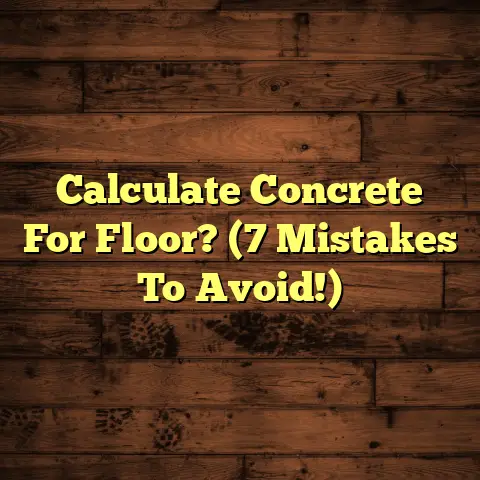Roomba on Floors? (4 Must-Know Settings!)
In a world where cleanliness meets convenience,
mastering your Roomba’s settings isn’t just
a luxury; it’s an absolute necessity for every
modern household.
Let’s dive in and make sure
you’re getting the most out of your robotic
cleaning companion.
Understanding Roomba’s Technology
As a flooring contractor, I’ve seen it all.
From the dust bunnies under the couch to the
crumbs mysteriously accumulating in corners,
floors take a beating.
That’s where the Roomba
comes in.
But it’s not just a mindless vacuum
on wheels.
The Brains Behind the Bot
Roomba’s are packed with tech.
We’re talking
sensors that detect edges, cliffs, and obstacles.
Algorithms that map your room for efficient
cleaning.
And for the smarter models, mapping
capabilities that remember your floor plan.
Think of it like this: it’s constantly learning
and adapting.
These features work together to
ensure your floors are cleaned thoroughly and
safely.
Floor Types and Roomba’s Adaptability
Now, here’s where my expertise comes in.
Different floor types require different cleaning
approaches.
Hardwood needs a gentle touch, while
carpet demands more aggressive suction.
Tile?
Well, that’s somewhere in between.
Roomba’s are designed to adapt.
They can
detect the type of flooring and adjust their
cleaning power accordingly.
But here’s the key:
you need to know how to help it along.
For example, a Roomba may struggle on very
thick, plush carpets.
I’ve seen it happen!
Understanding these limitations is crucial for
optimal cleaning.
Setting 1: Cleaning Modes
Okay, let’s get into the nitty-gritty.
Roomba’s offer various cleaning modes, each
designed for specific tasks.
Knowing which mode
to use can significantly improve your cleaning
results.
Auto Mode: The Everyday Hero
This is your go-to mode for general cleaning.
The Roomba will navigate your entire floor,
cleaning as it goes.
It’s perfect for maintaining
a consistently clean home.
Spot Mode: Targeted Cleaning
Spilled some cereal?
Pet made a mess?
Spot mode is your friend.
Place the Roomba in
the center of the mess, and it will clean a
concentrated area.
Edge Cleaning Mode: No Corner Left Behind
This mode focuses on cleaning along walls and
edges.
It’s great for getting those hard-to-reach
areas where dust and debris tend to accumulate.
Max Mode: Deep Cleaning Power
Some Roomba models offer a “Max” mode, which
increases suction power for deep cleaning.
This
is ideal for carpets or high-traffic areas that
need extra attention.
Choosing the Right Mode
So, how do you choose?
Well, it depends on the
situation.
For daily maintenance, Auto mode is
perfect.
For quick cleanups, Spot mode is your
best bet.
And for a thorough cleaning, don’t
forget about Edge cleaning mode!
Setting 2: Virtual Barriers and No-Go Zones
Ever wish you could tell your Roomba where not
to go?
That’s where virtual barriers and no-go
zones come in.
These features allow you to create
boundaries that the Roomba won’t cross.
Protecting Your Valuables
I can’t tell you how many times I’ve seen
Roombas get stuck under furniture or knock over
delicate items.
Virtual barriers can prevent these
accidents.
Setting Up Virtual Barriers
Most Roomba models use either physical barriers
or virtual ones through the app.
Physical barriers
are small devices that emit an infrared beam,
creating an invisible wall.
App-based barriers
let you draw no-go zones directly on the map of
your home.
Benefits of No-Go Zones
Imagine protecting your pet’s food and water bowls
from being bumped around.
Or keeping the Roomba
out of areas with delicate rugs.
No-go zones give
you that control.
Enhancing Cleaning Efficiency
By strategically placing virtual barriers, you can
guide the Roomba to focus on areas that need the
most attention.
This not only saves time but also
ensures a more thorough cleaning.
Setting 3: Scheduling and Routines
Consistency is key when it comes to cleaning.
That’s why scheduling and routines are essential
for maximizing your Roomba’s effectiveness.
Setting Up a Cleaning Schedule
Most Roomba models allow you to set up a daily
or weekly cleaning schedule through the app.
This means you can have your floors cleaned
automatically, even when you’re not home.
Why Scheduling Matters
Think about it: setting a routine ensures that
dirt and dust don’t accumulate over time.
It’s
like having a cleaning crew that works while you
relax.
Adjusting for Seasonal Changes
As a flooring contractor, I know that cleaning
needs change with the seasons.
During shedding
season, pet owners might want to increase the
frequency of cleaning.
Similarly, during the
winter months, you might want to focus on areas
where dirt and salt are tracked in.
Tips for Effective Scheduling
Consider your household’s traffic patterns and
dirt accumulation.
Set your Roomba to clean
during off-peak hours to minimize disruptions.
And don’t be afraid to adjust your schedule as
needed.
Setting 4: Maintenance Alerts and Cleaning Preferences
To keep your Roomba running smoothly, you need
to pay attention to maintenance alerts and cleaning
preferences.
These settings help prolong the
Roomba’s life and ensure optimal performance.
The Importance of Maintenance
Like any other appliance, Roomba’s require regular
maintenance.
This includes cleaning the brushes,
emptying the dustbin, and replacing the filters.
Understanding Maintenance Alerts
Your Roomba will typically alert you when it’s
time to perform maintenance tasks.
Pay attention
to these alerts!
Ignoring them can lead to reduced
cleaning performance and even damage to the device.
Personalizing Cleaning Preferences
The Roomba app allows you to customize various
cleaning preferences, such as suction power and
cleaning frequency.
Experiment with these settings
to find what works best for your home.
Accessing and Customizing Preferences
In the Roomba app, navigate to the settings menu
to access cleaning preferences.
From there, you
can adjust various parameters to tailor the
cleaning experience to your needs.
Tailoring Cleaning Experience
Do you have pets?
Increase the suction power.
Do you have delicate hardwood floors?
Reduce the
cleaning frequency.
The key is to find a balance
that keeps your floors clean without causing damage.
Conclusion
So, there you have it.
The four must-know settings
for your Roomba: cleaning modes, virtual barriers,
scheduling, and maintenance alerts.
Mastering
these settings can transform the way you experience
floor cleaning.
It’s not just about convenience; it’s about
maintaining a spotless home with minimal effort.
By understanding and utilizing these settings,
you can maximize the value of your Roomba and enjoy
clean floors every day.
Now go forth and conquer those dust bunnies!
Your floors (and your Roomba) will thank you.





